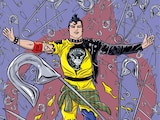Eighty-two years since her first appearance in All-Star Comics #8, Wonder Woman continues to be a revolutionary character. We are reminded of this again and again while reading Wonder Woman: Outlaw, which collects the first six issues of Tom King and Daniel Sampere’s ongoing run. And while many of us certainly don’t need to be reminded of Wonder Woman’s revolutionary status, King and Sampere’s vision of her character is forged with such intensity that even the most seasoned DC readers will feel a chill up their spine. Even when the core elements of her character are laid bare, Wonder Woman: Outlaw signals an urgent rebirth of the heroine in our contemporary age.
Wonder Woman: Outlaw is a story of dreams and nightmares, of truth and lies. The graphic novel begins when an Amazon named Emelie murders a group of men at a bar, sparking a wave of anti-Amazon sentiment across the United States. The American government responds by sending Sergeant Steel to track down every Amazon living in the United States and demand that she either go back to her homeland or be killed. In an utterly heartbreaking scene, we see an Amazonian warrior confront Steel and his men, only to be shot and killed by Steel’s new Amazon-killing bullets. These rounds pierce Amazonian steel like tissue paper, and the image of the murdered Amazon’s bullet-riddled shield is absolutely haunting. Meanwhile, Wonder Woman searches for Emelie, hoping to resolve the situation through her ideals of truth and justice.

When Sergeant Steel tracks down Diana herself, the heroine offers one simple response to his request: “No thank you.” It’s a phrase that is echoed across the story, even as the threats against Wonder Woman’s life mount. In a fight scene that is sure to become a classic, Wonder Woman battles Sergeant Steel’s men in a snowy cemetery using nothing but her tiara, bracelets and lasso. Artist Daniel Sampere draws Wonder Woman’s body in motion with an equal sense of balletic grace and athletic power. There is poetry in every one of Sampere’s lines. I will never tire of seeing Wonder Woman throw her tiara at her attackers like a boomerang.
Under Sampere’s pen, Diana takes up vast amounts of space on the page. She is often drawn from a low-angle perspective, emphasizing her tall stature and muscled physique. Even when she isn’t in battle, she stands up straight to her full height. This establishes how Wonder Woman refuses to make herself smaller so insecure men can feel comfortable around her. This works perfectly to counter Steel’s desire to stamp out Amazons from American soil, the visual equivalent of her “No thank you” catchphrase.

King and Sampere beautifully capture the balance between Wonder Woman’s fierceness as a warrior and her charismatic and kind personality. In one scene, she beams down at a front desk person who had absentmindedly brushed aside her requests to speak to Sergeant Steel. She maintains her patience as the receptionist trips over his own words when he finally realizes who is talking to him. Later, even as security personnel fire bullets while cursing and shouting at her, Diana simply states “No thank you.” Though the story does not shy away from confronting topics such as misogyny, Wonder Woman’s charming personality keeps the tone of the book from ever feeling hopeless.
Wonder Woman has always wanted humanity to live their truth, but in Outlaw, that dream has never felt more thorny. Diana’s signature Lasso of Truth now has a new dark foil in the Lasso of Lies, which is used to propagate false misogynistic ideals. The nightmare that the Lasso of Lies plunges the United States into reveals the extent to which our dreams and nightmares define who we are. While Diana had once been lauded for wearing American colors in her uniform and calling the United States home, the anti-Amazon sentiment in the country signals a regression driven by fear. Instead of being led by optimism and a desire to evolve, Wonder Woman’s America—in a punch-to-the-face comment on our own—is now ruled by a type of fear that can only be placated by lies. This cuts to the very heart of Wonder Woman’s character. It leaves us room to consider what defines our vision of America: is it its dreams and ideals…or its lies and deceit?

Whether you are a longtime Wonder Woman reader or a complete newcomer, Tom King and Daniel Sampere’s Wonder Woman: Outlaw is not to be missed. From its breathtaking action scenes to its gut-wrenching emotional stakes, Wonder Woman: Outlaw is a fearless celebration of Diana’s ideals for a time where they’re continually under assault. For better or for worse, the world still needs Wonder Woman all these years later. Today, she blends seamlessly with our political landscape, giving us space to reflect, feel and even dream.
Wonder Woman Vol. 1: Outlaw by Tom King, Daniel Sampere and Tomeu Morey is available in bookstores, comic shops, libraries and digital retailers. It can also be read in full on DC UNIVERSE INFINITE.
Jules Chin Greene writes about comics, TV, games and film for DC.com, and his work can also be found at Nerdist, Popverse and Multiverse of Color. You can follow him on Twitter and Bluesky at @JulesChinGreene.
NOTE: The views and opinions expressed in this feature are solely those of Jules Chin Greene and do not necessarily reflect those of DC or Warner Bros. Discovery, nor should they be read as confirmation or denial of future DC plans.















